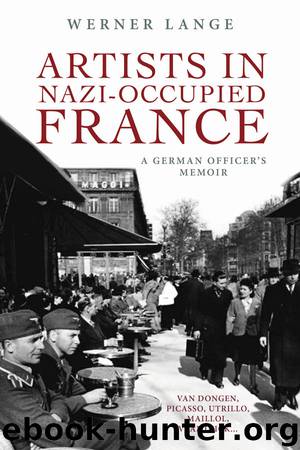Artists in Nazi-Occupied France by Werner Lange

Author:Werner Lange
Language: eng
Format: epub
ISBN: 9781771613316
Publisher: Mosaic Press
Published: 2018-07-29T16:00:00+00:00
——————
1. André Metthey, a very active art dealer under the Occupation. The owner of the Élysée Gallery. (EdN)
THE RUDIERS
The Rudier Art Foundries1 were located in Malakoff, at the entrance to Paris. The business which had to close after the war, after Eugène Rudier’s death, was a remarkable institution, one–of–a kind, and enjoyed a world-wide reputation. The signature “Alexis Rudier, Foundry Artist, Paris,” at the base of a bronze, was the guarantee of irreproachable quality. The most beautiful and perfect of qualities. The Rudiers were the ones who cast the works of Rodin, Bourdelle and Maillol.
In Malakoff, a large main entrance opened up onto a narrow, but deep courtyard. At the entrance, a modest office where the secretary worked; at the back, the foundries themselves. That courtyard was a veritable museum. Bronzes already cast waited there to be picked up by their owners. It was in the sun and under the rain that their patinas were completed. On arriving, I saw a Penseur (Thinker) by Rodin, and, further on, a Bourgeois de Calais (Burger of Calais),2 L’Ombre3 even further on, and, at the very back, Les Trois Grâces (The Three Graces) by Maillol. It was magical!
Before accessing the workshops, one passed through a vast hall where Rudier would stock his plasters and castings. There were many works by Rodin, Maillol and nudes by Despiau. On the back wall one could see hanging the large semi-circular casting of the Diane couchée avec le cerf (Diana sleeping with the stag) by Benvenuto Cellini, the ancient founding of which is housed at the Louvre. The original, one can say, was cast in France because it had to serve as an impost at the chateau of Fontainebleau. Later on, Henri II offered it as a gift to Diane de Poitiers, to adorn the door of her chateau d’Anet. Happy to see me, since we were already friends, Rudier explained to me that this Diane was the first casting commissioned by the Germans. It was a special commission from Marshal Goering, intended to decorate his hunting castle of Carinhall.4 What luck that he was content with a copy, I had thought. He could have easily confiscated the original from the Louvre! Goering had ordered a copy to be made of another Diane d’Anet, the one by Jean Goujon. Thinking he was a great connoisseur that he obviously was not, he ordered one of the dogs removed. This removal destroyed Goujon’s marvelous composition. Shortly before the Allies landed, he had also commissioned a copy of the Victoire de Samothrace (The Victory of Samothrace). But since Paris was on the verge of falling, and the work on the copy was not completed, the unfinished work was shipped as is, to be finished in Germany. I had heard this story much later. It left me speechless.
In Rudier’s large workshop, the plasters were set up on shelves, all along the walls. The middle of the room thus remained quite open. Here was where the workers brought or stored the bronzes already cast and polished, ready for the final touch, the patina.
Download
This site does not store any files on its server. We only index and link to content provided by other sites. Please contact the content providers to delete copyright contents if any and email us, we'll remove relevant links or contents immediately.
Fanny Burney by Claire Harman(26254)
Empire of the Sikhs by Patwant Singh(22775)
Out of India by Michael Foss(16695)
Leonardo da Vinci by Walter Isaacson(12815)
Small Great Things by Jodi Picoult(6693)
The Six Wives Of Henry VIII (WOMEN IN HISTORY) by Fraser Antonia(5242)
The Wind in My Hair by Masih Alinejad(4852)
The Crown by Robert Lacey(4578)
The Lonely City by Olivia Laing(4576)
A Higher Loyalty: Truth, Lies, and Leadership by James Comey(4565)
The Iron Duke by The Iron Duke(4126)
Millionaire: The Philanderer, Gambler, and Duelist Who Invented Modern Finance by Janet Gleeson(4116)
Papillon (English) by Henri Charrière(3923)
Sticky Fingers by Joe Hagan(3916)
Joan of Arc by Mary Gordon(3797)
Alive: The Story of the Andes Survivors by Piers Paul Read(3743)
Stalin by Stephen Kotkin(3731)
Aleister Crowley: The Biography by Tobias Churton(3435)
Ants Among Elephants by Sujatha Gidla(3282)
